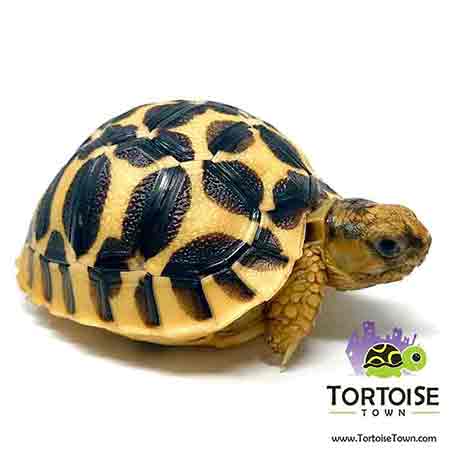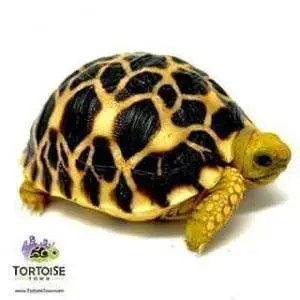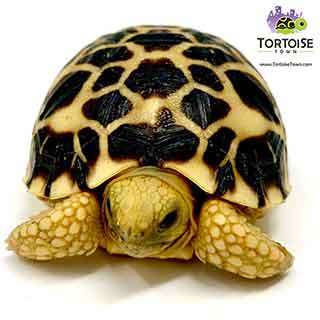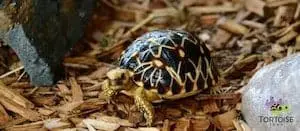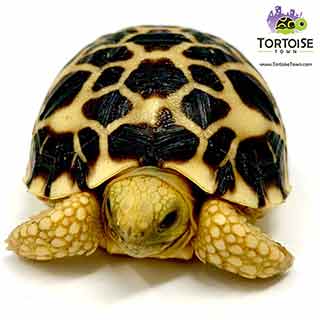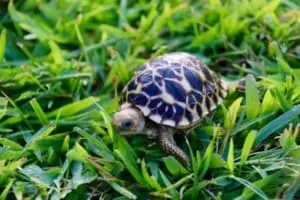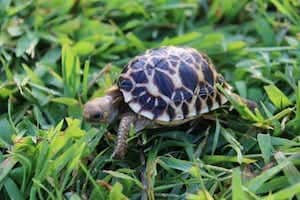Burmese Star tortoise Life Span
Geochelone platynota are like most tortoise species, considered to be long lived. The average Burmese Star tortoise for sale captively bred, should live anywhere from 50-100 years. Long-lived when well cared for, this is an incredibly hardy species.
Burmese Stars are probably the easiest to care for of all the star tortoise species. Until recently, there was very little information concerning Burmse Star tortoise lifespan, partly due to the species’ lack of experience in human care. With its adaptive nature, the Burmese star tortoise is one of the easiest of all the Star tortoise for sale to care for.
Burmese Star Tortoise Care
Interested in buying a baby Burmese star tortoise for sale? Before you make your purchase, be sure to explore proper Burmese Star tortoise care below. Burmese Star Tortoise (Geochelone platynota) is one of the most attractive species of tortoise for sale in the world. Known for their amazing back over gold shell and pattern, baby Burmese star tortoises are sought after by most collectors. Captive bred baby Burmese star tortoise for sale are available though pricey, thru select breeders, like our tortoise farm here at tortoise town.
An attractive species, the burmese star tortoise features an oblong and moderately domed carapace that is dark in color (black to deep brown). Each scute or plate is stamped with a beautiful star or flower petal pattern which is different than that of the indian star tortoise (G. elegans). This pattern is yellow or cream colored and may cover a larger portion of the scute depending on the individual. “Wide banding” of the pattern, as it is sometimes referred to as in more aesthetically pleasing specimens, is highly sought after by collectors searching for burmese star tortoise for sale. However, all Burmese stars are something to see regardless of the abundance or “width” of the star/petal pattern on the shell.
Explore our full Burmese Star care sheet or choose from the care related pages below:
- Burmese Star tortoise care guide
- Burmese Star tortoise for sale
- baby Burmese Star tortoise habitat
- Adult Burmese Star tortoise color
- Burmese Star tortoise size
- Burmese Star tortoise habitat
- baby Burmese Star tortoise humidity
- Burmese Star tortoise lifespan
- Burmese Star tortoise temperature
- baby Burmese star tortoise lighting
- Burmese Star tortoise diet
Burmese star tortoise color
One of the most beautiful tortoises in the world, the Burmese star is a gorgeous animal. Bright yellow bands over a deep black shell, and even bright yellow arms, legs and head.
On each of the five vertebral scutes that span the spinal length of the carapace, platynota feature no more than six lines or points that sprout from the center marking of each scute. The first scute usually shows five lines which then increases to six on the second scute, third and so on and so forth. The rays or points of yellow will span the entire scute and meet the ends of others to form almost a “netted” pattern when looking at the Burmese star from above.
The Burmese stars’ plastron will be covered with dark, triangular or trapezoidal shaped marks with a base that is light tan or yellow. There is a very different pattern on the plastron that enables us to tell the difference from the Burmese and Indian Star tortoise for sale. The head of the Burmese star is yellowish or light colored with fewer dark areas than the head of the Indian star. Long, powerful legs with thick scales enable the tortoise to walk “tall and proud”. Large, dark eyes on either side of the head protrude and give this species a rather wise yet comical look. Geochelone platynota can attain considerable dimensions with females surpassing 12 inches.
This species is in serious trouble in its native Myanmar and is considered by some to be virtually extinct in nature.
Burmese Star tortoise Availability
This species of tortoise has never been at a high abundance level such as Indian star, Sulcata, red foot tortoise and Russian tortoises but in recent years, dedicated keepers are having success. Yearly, captive bred hatchling and juvenile Burmese star tortoises can be found for sale from experienced breeders and occasionally but still quite rarely, adults will be offered.
Regardless of age, these tortoises fetch a high price and are considered to be very valuable. Their extinction-like situation in the wild only adds to their value making them tough to resist owning for the serious tortoise enthusiast. Not to mention, their gorgeous appearance. At Garden State Tortoise, we occasionally offer hatchlings for sale from absolutely stunning adults.
Burmese Star Tortoise Habitat
So you’ve deciding to buy a Burmese star tortoise, congrats! Now you need to do your research, to get your habitat setup correctly. Housing a Burmese star tortoise is easy, so long as you do your research. First, ask yourself if you want to build permanent Burmese star tortoise habitat. If not, you can setup a new one every few years as your baby Burmese star tortoise grows.
Setting up a habitat for the first 2-3 years of life being smaller is recommended. By having a small Burmese star tortoise enclosure, you will be able to keep the humidity high, and the airflow low, as babies need it. It is not understood by many how much better baby Burmese star tortoise do with high humidity and low air flow. Lower air flow prevents dehydration as well as keeping humidity higher. Here at our tortoise farm, we use 2×4′ sealed containers with minimal ventilation. Using a reptile closed system that has one front glass door works great. Using a reptile fogger system is great for babies and adults to raise humidity.
Indoor vs outdoor Burmese star tortoise habitats
Depending on your location, this species can be housed either indoors or out. Several keepers swear by housing them inside in artificial, controlled conditions and while this method clearly has proven to be successful, natural sunlight is always beneficial. In Myanmar, they inhabit dry, deciduous forests but adapt well in captive situations.
If you are housing your adult Burmese star tortoise outside, try using rail road ties, or cinder block walls to setup your perimeter. These both work well as Burmese Star tortoises are not known for digging. Certain species of tortoise may require you to setup your walls below ground as they dig, but not stars. Star tortoises are reasonably easy to keep as they rarely try to climb, or dig to escape their habitat.
Burmese Star tortoises do like shade and cover to feel secure. Using low growing bushes or shrubs offer cover as so pieces of wood, rocks etc. Clean, fresh, water should always be available via dishes, or terra cotta dishes that are dug and sunken into the ground. Using a cold frame as a shelter works well and enables them to stay warmer if temperatures drop. Burmese stars tolerate a decent temperature range with heat all the way up to 100 and cold down as low as 40 degrees. Regardless with temps dipping below 60 degrees, in the evenings, a heater shelter should always be available.
Finding the right baby Burmese star tortoise for sale
Interested in buying a baby Burmese star tortoise for sale? Before you make your purchase, be sure to explore proper Burmese Star tortoise care below. Burmese Star Tortoise (Geochelone platynota) is one of the most attractive species of tortoise for sale in the world. Known for their amazing back over gold shell and pattern, baby Burmese star tortoises are sought after by most collectors. Captive bred baby Burmese star tortoise for sale are available though pricey, thru select breeders, like our tortoise farm here at tortoise town.
An attractive species, the burmese star tortoise features an oblong and moderately domed carapace that is dark in color (black to deep brown). Each scute or plate is stamped with a beautiful star or flower petal pattern which is different than that of the indian star tortoise (G. elegans). This pattern is yellow or cream colored and may cover a larger portion of the scute depending on the individual. “Wide banding” of the pattern, as it is sometimes referred to as in more aesthetically pleasing specimens, is highly sought after by collectors searching for burmese star tortoise for sale. However, all Burmese stars are something to see regardless of the abundance or “width” of the star/petal pattern on the shell.
Burmese Star Tortoise Lighting, Temperature and Humidity
Burmese Star tortoise require a 10.0 or 10% UVB lamp as their main source of UVB. Additionally, they enjoy a hot spot that is in the neighborhood of 92-95 Degrees. Typically, you are providing the heat thru a basking lamp or CHE (Ceramic Heat Emitter). For UVB lamps, we recommend a t5 high output tube style UVB. Arcadia brand lamps are best, however Reptisun also work, they just need to be changed more often.
Mercury vapor bulbs of 150 watts provide an excellent basking situation for platynota and they emit both UVA and UVB rays. MVA lamps do tend to lose the intensity of the UV quickly, so replace them every six months or so. Using these in combination with 10.0 UVB fluorescent tube doesn’t hurt. These bulbs work for both hatchlings, juveniles and adults but be careful with hatchlings. The powerful Mercury vapor bulbs can dry them out quickly. Keeping a relative humidity level of between 75 and 85% helps the tortoises stay well hydrated and aids in preventing excessive pyramiding of the shell.
Changing your UVB tortoise lights
Here at the farm, we change our Arcadia lamps every 9-10 months, and our Zoomed Reptisun brands every 4-5 months As stated above, Burmese star tortoises can tolerate temperature fluctuation but are of course most active and do best when it’s warm. Ambient room temperature should remain in the 80s with a basking spot of 100F or more. It is not necessary to add an additional heat source at night and the room can be allowed to drop significantly.
All ages of Burmese stars should have constant access to fresh water via shallow dishes or poultry waterers (which I have found to be easier to clean and even keep clean because the tortoises can drink from them, but not usually defecate in them). Burmese star tortoises are particularly fond of rain showers and react quickly to them by relieving themselves and tromping around during them. They will extend their necks into the falling rain and drink from puddles. Spraying them down with the garden hose on hot days does not go unnoticed. Indoors, spray bottles can be used or you can install a misting system. I have found the ExoTerra monsoon system to be very effective for platynota and all other tortoise species, especially neonates.
Burmese Star tortoise Substrate
Indoors, I have the most success using cypress mulch. It holds humidity well and offers good traction. The tortoises can burrow in it if they feel the need and I use clay dishes when offering food to avoid ingestion of it. The 50/50 mix of top soil and play sand mentioned earlier works indoors as well but is of course messier.
Burmese Star tortoise Food
Burmese star tortoises will accept a wide variety of foood items and ours are offered the following: Mazuri tortoise diets, fresh organic weeds (dandelion, clover, cat’s ear, wild strawberry, plantain, hawksbit and thistle) and the occasional produce (collards, mustards, turnip greens and squashes), fruits very sparingly (papaya, banana, tomato, strawberries) and herbs. I also practice a method of mixing Mazuri tortoise chow with various organic, dried herbs that I buy in bulk online. It’s an excellent way to feed our platynota and all other tortoise species especially during the winter when more natural items are not easily accessible. Watch the video I put together about this: Tortoise Feeding Tip (Using Organic Dried Herbs)
Burmese Star tortoise Temperament
Of all the tortoises in captivity, the Burmese star quite possibly has one of the best personalities out there. They are highly adaptive and have proven to thrive in captive situations. This species quickly learns to associate its keeper as the food source and will enthusiastically approach in search of something to eat. We can even pet and scratch our Burmese stars’ heads and necks, they rarely flinch or withdraw into their carapaces. A very, very outgoing and responsive tortoise to work with.
Burmese Star tortoise Reproduction and Breeding
Despite the turmoil and bleak future theu face in nature, Geochelone platynota has proven to be quite prolific in captivity. Warm rains and a rise in humidity can trigger courtship. Males will relentlessly pursue females to get the job done and some keepers have found that housing a somewhat higher number of males than what is usually suggested, may help in fertility and frequency of egg laying. Outdoors, the female will choose a sandy or loamy, sun drenched spot to deposit her clutch of eggs. Indoors, we use recessed plastic nesting boxes in our wooden enclosures.
A hole is cut the size of the plastic container we choose to use into the bottom of the unit and the container is then sunken into place. It is then filled with a sand/soil mix. A heat lamp is hung above it and here, the females will dig a deep nest and deposit her eggs. Sometimes more than 12 eggs are laid, but usually less is common. The eggs are first placed in a sort of “pre-incubation” stage for the first week at room temperature (about 75F).
They are then subjected to a cooling period for roughly 30 days at 65F-70F. After that they are warmed back up to room temperature for another week before being consistently incubated at between 86 and 90F and they will then hatch in about 90 days. Like many species, the sex of the tortoises is determined by the incubation temperature with the lower resulting in males, the higher in females. Over 90F can harshly subject the hatchlings to deformities and defects.
Burmese Star tortoise egg incubation
The incubation techniques for Geochelone platynota vary from keeper to keeper with an array of results. This valuable information provided with consent from Chris Leone of Garden State Tortoise, LLC.
Over 25 Species of captive bred tortoises for sale
Other species of tortoise for sale offered here include giant tortoises like the Aldabra tortoise, Sulcata tortoise, Burmese mountain tortoise and more. Medium size species include the leopard tortoise, red-footed tortoise, yellow foot tortoise, mountain tortoise, Burmese star tortoise and the giant leopard tortoise. Small tortoise for sale includes Hermann’s tortoise, Greek Tortoise, Indian Star tortoise, Pancake Tortoise, Russian tortoise and the Egyptian tortoise. Above all, we’ve got the widest selection of tortoise for sale in the USA, including baby tortoise, juveniles and adult tortoises for sale.

